Title search results
Showing 1488061 - 1488080 of 1502829 items
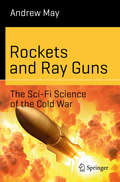
Rockets and Ray Guns: The Sci-Fi Science of the Cold War (Science and Fiction)
By Andrew May. 2018
The Cold War saw scientists in East and West racing to create amazing new technologies, the like of which the…
world had never seen. Yet not everyone was taken by surprise. From super-powerful atomic weapons to rockets and space travel, readers of science fiction (SF) had seen it all before. Sometimes reality lived up to the SF vision, at other times it didn’t. The hydrogen bomb was as terrifyingly destructive as anything in fiction, while real-world lasers didn't come close to the promise of the classic SF ray gun. Nevertheless, when the scientific Cold War culminated in the Strategic Defence Initiative of the 1980s, it was so science-fictional in its aspirations that the media dubbed it “Star Wars”. This entertaining account, offering a plethora of little known facts and insights from previously classified military projects, shows how the real-world science of the Cold War followed in the footsteps of SF – and how the two together changed our perception of both science and scientists, and paved the way to the world we live in today.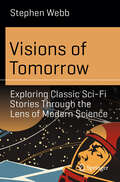
This anthology invites readers to revisit twelve timeless stories from visionary authors while pondering the scientific advancements they foreshadowed, making…
it ideal for fans of both science fiction and science. In Algernon Blackwood’s A Victim of Higher Space, the concept of extra spatial dimensions is explored, while Miles J. Breuer’s The Gostak and the Doshes examines time as a dimension in relativity. Stanley Waterloo’s Love and a Triangle touches on efforts to communicate with extraterrestrial intelligence, and Max Adeler’s The Fortunate Island raises questions about humanity’s readiness for first contact with alien life. Machine learning and AI feature in Edward L. Sabin’s The Supersensitive Golf Ball, while Saki’s Filboid Studge explores targeted advertising’s transformation through AI. Edward Bellamy’s With the Eyes Shut predicts devices like smartphones and sparks discussions on the future of scientific publishing. G.K. Chesterton’s The Tremendous Adventures of Major Brown delves into augmented, virtual, and mixed reality technologies. Edgar Wallace’s The Black Grippe provides a historical lens on pandemics and communication of scientific uncertainty. J. Arbuthnot Wilson’s PAUSODYNE looks at suspended animation and modern cryonics, while Edgar Allan Poe’s The Facts in the Case of M. Valdemar tackles advances in medical technology and definitions of death. Finally, Guy de Maupassant’s The Horla explores the potential for humanity to be supplanted by new life forms.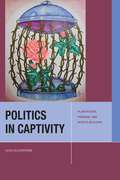
Politics in Captivity: Plantations, Prisons, and World-Building (Just Ideas)
By Lena Zuckerwise. 2024
From the 1811 German Coast Slave Rebellion to the 1971 Attica Prison Uprising, from the truancy of enslaved women to…
the extreme self-discipline exercised by prisoners in solitary confinement, Black Americans have, through time, resisted racial regimes in extraordinary and everyday ways. Though these acts of large and small-scale resistance to slavery and incarceration are radical and transformative, they have often gone unnoticed. This book is about Black rebellion in captivity and the ways that many of the conventional well-worn constructs of academic political theory render its political dimensions obscure and indiscernible. While Hannah Arendt is an unlikely theorist to figure prominently in any discussion of Black politics, her concepts of world and worldlessness offer an indispensable framework for articulating a theory of resistance to chattel and carceral captivity. Politics in Captivity begins by taking seriously the ways in which slavery and incarceration share important commonalities, including historical continuity. In Zuckerwise’s account of this commonality, the point of connection between enslaved and incarcerated people is not exploited labor, but rather resistance. The relations between the rebellions of both groups appear in the writings of Muhammed Ahmad, Angela Davis, George Jackson, Ruchell Magee, and Assata Shakur, a genre Zuckerwise calls Black carceral political thought. The insights of these thinkers and activists figure into Zuckerwise’s analyses of largescale uprisings and quotidian practices of resistance, which she conceives as acts of world-building, against conditions of forced worldlessness. In a moment when a collective racial reckoning is underway; when Critical Race Theory is a target of the Right; when prison abolition has become more prominent in mainstream political discourse, it is now more important than ever to look to historical and contemporary practices of resistance to white domination.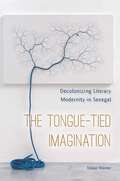
The Tongue-Tied Imagination: Decolonizing Literary Modernity in Senegal
By Tobias Warner. 2019
Winner, 2021 African Literature Association First Book AwardShould a writer work in a former colonial language or in a vernacular?…
The language question was one of the great, intractable problems that haunted postcolonial literatures in the twentieth century, but it has since acquired a reputation as a dead end for narrow nationalism. This book returns to the language question from a fresh perspective. Instead of asking whether language matters, The Tongue-Tied Imagination explores how the language question itself came to matter. Focusing on the case of Senegal, Warner investigates the intersection of French and Wolof. Drawing on extensive archival research and an under-studied corpus of novels, poetry, and films in both languages, as well as educational projects and popular periodicals, the book traces the emergence of a politics of language from colonization through independence to the era of neoliberal development. Warner reads the francophone works of well-known authors such as Léopold Senghor, Ousmane Sembène, Mariama Bâ, and Boubacar Boris Diop alongside the more overlooked Wolof-language works with which they are in dialogue.Refusing to see the turn to vernacular languages only as a form of nativism, The Tongue-Tied Imagination argues that the language question opens up a fundamental struggle over the nature and limits of literature itself. Warner reveals how language debates tend to pull in two directions: first, they weave vernacular traditions into the normative patterns of world literature; but second, they create space to imagine how literary culture might be configured otherwise. Drawing on these insights, Warner brilliantly rethinks the terms of world literature and charts a renewed practice of literary comparison.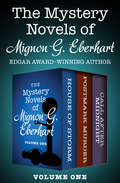
The Mystery Novels of Mignon G. Eberhart Volume One: House of Storm, Postmark Murder, and Call After Midnight
By Mignon G. Eberhart. 1956
In these three novels of romantic suspense, the Edgar Award winner proves once again that she &“can weave an almost…
flawless mystery&” (The New Yorker). In a prolific career that spanned seven decades, Mignon G. Eberhart made a name for herself as &“America&’s Agatha Christie.&” Praised by fellow writers ranging from Gertrude Stein, who called her &“one of the best mystifiers in America,&” to Mary Higgins Clark, who hailed her as &“one of America&’s favorite writers,&” Eberhart penned classic mystery novels of romantic suspense, usually with female leads and often set in exotic locales. The three novels collected here—written in 1949, 1955, and 1964—offer further evidence that &“Eberhart&’s name on mysteries is like sterling on silver&” (Miami News). House of Storm: On a Caribbean island in the path of a hurricane, Nonie is torn between the older man she&’s engaged to and the man she&’s truly in love with—a suspected murderer. &“Mounting tension . . . one of [Eberhart&’s] most successful glamour romances yet.&” —The New York Times Postmark Murder: Following the death of a wealthy Chicago businessman, his ward Laura March must protect her fellow heir—an orphaned girl from Poland—and clear herself of a murder after a mysterious stranger is stabbed. &“A nice example of [Eberhart&’s] powers . . . Intelligently complicated.&” —The New Yorker Call After Midnight: A late-night phone call from Jenny Vleedam&’s ex-husband revealing that his girlfriend has been shot places the divorcée in danger. &“Eberhart tells one of her better mystery-romances in Call After Midnight.&” —The New York Times
Bertie Ahern Autobiography: The Autobiography
By Bertie Ahern. 2009
Bertie Ahern, three times Irish Taoiseach, is often described as an enigma. The Old IRA man's son who delivered peace…
in Northern Ireland. A working class boy responsible for the Celtic Tiger. The man of faith who ushered in progressive, cosmopolitan secular Ireland. An ardent nationalist admired by European leaders. 'I know 25 per cent of Bertie Ahern', said his finance minister, Charlie McCreevy, 'and that's 24 per cent more than anyone else.'Now in this frank and revealing autobiography, Ahern gives his own account of a remarkable political life and the personal story that accompanies it. He shows the cost to his family of a life played out in the public eye and, for the first time, discloses what really happened in his final weeks in power.Here for the first time is the truth behind the man who is Bertie.Ahern has been at the cutting edge of Irish politics for over three decades. He was first elected to Dáil Éireann in the Fianna Fáil landslide victory in 1977 that saw Jack Lynch returned as Taoiseach. In 1982, Charles Haughey appointed him Government Chief Whip. In volatile political times, he strongly supported Haughey during three challenges to his leadership of Fianna Fáil.In 1987, Bertie Ahern received his first cabinet portfolio as Minister for Labour. It was a time when the Irish economy was in crisis. Ireland had a higher debt per head than Ethiopia or Sudan. Unemployment stood at 16%. Ahern negotiated Ireland's first social partnership agreement, which underpinned economic recovery and put in place the foundations for a period of sustained growth. In 1991, he was appointed Minister for Finance. International commentators first began to refer to 'Ireland's Tiger economy' in this period. When Bertie Ahern left the Department of Finance in late 1994, for the first time in almost 30 years, Ireland had a budget surplus.Bertie Ahern succeeded Albert Reynolds as leader of Fianna Fáil in November 1994. Following the General Election in 1997, he became Ireland's youngest ever Taoiseach. The Ahern Era was a time of unprecedented progress in Irish society. Over the course of his tenure in office, Ireland's economy out-performed that of every other European country. For the first time ever, the number of people in employment in the State reached 2 million.Working closely with Bill Clinton and Tony Blair, Ahern won widespread acclaim for his perseverance and skill in negotiating the Good Friday Agreement, which has provided the political framework for a lasting peace in Northern Ireland.On the international stage, he was a respected figure who enjoyed an acclaimed Presidency of the European Council in 2004. He presided over the completion of the largest ever expansion of the EU and concluded negotiations on a European constitution. He is one of only five visiting statesmen to have addressed both the United States Congress and the Houses of Parliament in Westminster.At home, Ahern enjoyed phenomenal electoral support. He was the first Taoiseach since 1944 to win three successive General Elections.Bertie Ahern resigned on 6th May, 2008. He had served for ten years, ten months and ten days as Taoiseach.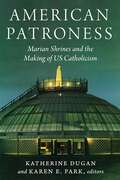
American Patroness: Marian Shrines and the Making of US Catholicism (Catholic Practice in the Americas)
By Katherine Dugan and Karen E. Park. 2024
A vital collection of interdisciplinary essays that illuminates the significance of Marian shrines and promises to teach scholars how to…
“read” them for decades to come.American Patroness: Marian Shrines and the Making of US Catholicism is a collection of twelve essays that examine the historical and contemporary roles of Marian shrines in US Catholicism. The essays in this collection use historical, ethnographic, and comparative methods to explore how Catholics have used Marian devotion to make an imprint on the physical and religious landscape of the United States. Using the dynamic malleability of Marian shrines as a starting place for studying US Catholicism, each chapter reconsiders the American religious landscape from the perspective of a single shrine to Mary and asks: What does this shrine reveal about US Catholicism and about American religion?Each of the contributors in American Patroness examines why and how Marian shrines persist in the twenty-first century and subsequently uses that examination to re-read contemporary US Catholicism. Because shrines are not neutral spaces—they reflect and shape the elastic yet strict boundaries of what counts as Catholic identity, and who controls prayer practices—the studies in this collection also shed light on the contested dynamics of these holy sites. American Patroness demonstrates that Marian shrines continue to be places where an American Catholic identity is continuously worked on, negotiations about power occur, and Marian relationships are fostered and nurtured in spaces that are simultaneously public and intimate.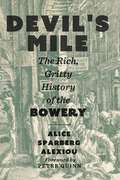
Devil's Mile: The Rich, Gritty History of the Bowery
By Alice Sparberg Alexiou. 2024
Devil’s Mile tells the rip-roaring story of New York’s oldest and most unique streetThe Bowery was a synonym for despair…
throughout most of the 20th century. The very name evoked visuals of drunken bums passed out on the sidewalk, and New Yorkers nicknamed it “Satan’s Highway,” “The Mile of Hell,” and “The Street of Forgotten Men.” For years the little businesses along the Bowery—stationers, dry goods sellers, jewelers, hatters—periodically asked the city to change the street’s name. To have a Bowery address, they claimed, was hurting them; people did not want to venture there.But when New York exploded into real estate frenzy in the 1990s, developers discovered the Bowery. They rushed in and began tearing down. Today, Whole Foods, hipster night spots, and expensive lofts have replaced the old flophouses and dive bars, and the bad old Bowery no longer exists.In Devil’s Mile, Alice Sparberg Alexiou tells the story of the Bowery, starting with its origins, when forests covered the surrounding area, and through the pre–Civil War years, when country estates of wealthy New Yorkers lined this thoroughfare. She then describes the Bowery’s deterioration in stunning detail, starting in the post-bellum years. She ends her historical exploration of this famed street in the present, bearing witness as the old Bowery buildings, and the memories associated with them, are disappearing.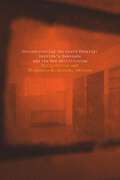
Deconstructing the Death Penalty: Derrida's Seminars and the New Abolitionism
By Kelly Oliver, Stephanie M. Straub. 2018
This volume represents the first collection of essays devoted exclusively to Jacques Derrida's Death Penalty Seminars, conducted from 1999 to…
2001. The volume includes essays from a range of scholars working in philosophy, law, Francophone studies, and comparative literature, including established Derridians, activist scholars, and emerging scholars. These essays attempt to elucidate and expand upon Derrida's deconstruction of the theologico-political logic of the death penalty in order to construct a new form of abolitionism, one not rooted in the problematic logics of sovereign power. These essays provide remarkable insight into Derrida’s ethical and political projects; this volume will not only explore the implications of Derrida’s thought on capital punishment and mass incarceration, but will also help to further elucidate the philosophical groundwork for his later deconstructions of sovereign power and the human/animal divide. Because Derrida is deconstructing the logic of the death penalty, rather than the death penalty itself, his seminars will prove useful to scholars and activists opposing all forms of state sanctioned killing. In compiling this volume, our goals were twofold: first, to make a case for Derrida's continuing importance in debates on capital punishment, mass incarceration, and police brutality, and second, to construct a new, versatile abolitionism, one capable of confronting all forms the death penalty might take.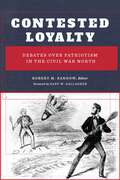
Contested Loyalty: Debates over Patriotism in the Civil War North (The North's Civil War)
By Robert M. Sandow. 2018
Embroiled in the Civil War, northerners wrote and spoke with frequency about the subject of loyalty. The word was common…
in newspaper articles, political pamphlets, and speeches, appeared on flags, broadsides, and prints, was written into diaries and letters and the stationary they appeared on, and even found its way into sermons. Its ubiquity suggests that loyalty was an important concept…but what did it mean to those who used it? Contested Loyalty examines the significance of loyalty across fault lines of gender, social class, and education, race and ethnicity, and political or religious affiliation. These differing vantage points reveal the complicated ways in which loyalties were defined, prioritized, acted upon, and related.While most of the scholarly work on Civil War Era nationalism has focused on southern identity and Confederate nationhood, the essays in Contested Loyalty examine the variable, fluid constructions of these concepts in the north. Essays explore the limitations and incomplete nature of national loyalty and how disparate groups struggled to control its meaning. The authors move beyond the narrow partisan debate over Democratic dissent to examine other challenges to and competing interpretations of national loyalty. Today’s leading and emerging scholars examine loyalty through: the frame of politics at the state and national level; the viewpoints of college educated men as well as the women they courted; the attitudes of northern Protestant churches on issues of patriotism and loyalty; working class men and women in military industries; how employers could use the language of loyalty to take away the rights of workers; and the meaning of loyalty in contexts of race and ethnicity.The Union cause was a powerful ideology committing millions of citizens, in the ranks and at home, to a long and bloody war. But loyalty to the Union cause imperfectly explains how citizens reacted to the traumas of war or the ways in which conflicting loyalties played out in everyday life. The essays in this collection point us down the path of greater understanding.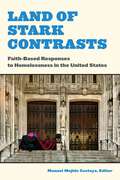
Land of Stark Contrasts: Faith-Based Responses to Homelessness in the United States
By Manuel Mejido Costoya. 2021
An important new volume showcasing a wide range of faith-based responses to one of today’s most pressing social issues, challenging…
us to expand our ways of understanding. Land of Stark Contrasts brings together the work of social scientists, ethicists, and theologians exploring the profound role of religion in understanding and responding to homelessness and housing insecurity in all corners of the United States—from Seattle, San Francisco, and Silicon Valley to Dallas and San Antonio to Washington, D.C., and Boston.Together, the essays of Land of Stark Contrasts chart intriguing ways forward for future initiatives to address the root causes of homelessness. In this way they are essential reading for practical theologians, congregational leaders, and faith-based nonprofit organizers exploring how to combine spiritual and material care for homeless individuals and other vulnerable populations. Social workers, nonprofit managers, and policy specialists seeking to understand how to partner better with faith-based organizations will also find the chapters in this volume an invaluable resource.Contributors include James V. Spickard, Manuel Mejido Costoya and Margaret Breen, Michael R. Fisher Jr., Laura Stivers, Lauren Valk Lawson, Bruce Granville Miller, Nancy A. Khalil, John A. Coleman, S.J., Jeremy Phillip Brown, Paul Houston Blankenship, María Teresa Dávila, Roberto Mata, and Sathianathan Clarke.Co-published with Seattle University’s Center for Religious Wisdom and World Affairs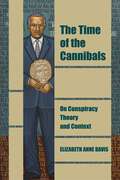
The Time of the Cannibals: On Conspiracy Theory and Context (Thinking from Elsewhere)
By Elizabeth Anne Davis. 2025
In 2009, the body of a former president of the Republic of Cyprus, Tassos Papadopoulos, was stolen from his grave.…
The Time of the Cannibals reconsiders this history and the public discourse on it to reconsider how we think about conspiracy theory, and specifically, what it means to understand conspiracy theories “in context.” The months after Papadopoulos’s body was stolen saw intense public speculation in Cyprus, including widespread expressions of sacrilege, along with many false accusations against Cypriots and foreigners positioned as his political antagonists. Davis delves into the public discourse on conspiracy theory in Cyprus that flourished in the aftermath, tracing theories about the grave robbery to theories about the division of Cyprus some thirty-five years earlier, and both to longer histories of imperial and colonial violence. Along the way, Davis explores cross-contextual connections among Cyprus and other locales, in the form of conspiracy theories as well as political theologies regarding the dead bodies of political leaders. Through critical close readings of academic and journalistic approaches to conspiracy theory, Davis shows that conspiracy theory as an analytic object fails to sustain comparative analysis, and defies any general theory of conspiracy theory. What these approaches accomplish instead, she argues, is the perpetuation of ethnocentrism in the guise of contextualization. The Time of the Cannibals asks what better kind of contextualization this and any “case” call for, and proposes the concept of conspiracy attunement: a means of grasping the dialogic contexts in which conspiracy theories work recursively as matters of political and cultural significance in the long durée.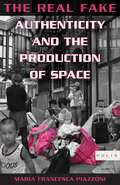
The Real Fake: Authenticity and the Production of Space (Polis: Fordham Series in Urban Studies)
By Maria Francesca Piazzoni. 2018
Thames Town—an English-like village built in Shanghai—is many places at once: a successful tourist destination, an affluent residential cluster, a…
city of migrant workers, and a ghost town. The Real Fake explores how the users of Thames Town transform a themed space into something more than a “fake place.” Piazzoni understands authenticity as a dynamic relationship between people, places, and meanings that enables urban transformations. She argues that authenticity underlies the social and physical production of space through both top-down and bottom-up dynamics. The systems of moral and aesthetic judgments that people associate with “the authentic” materialize in Thames Town. Authenticity excludes some users as it inhibits access and usage especially to the migrant poor. And yet, ideas of the authentic also encourage everyday spontaneous appropriations of space that break the village’s staged atmosphere. Most scholars criticize theming by arguing that it produces a “fake,” controlling city. Piazzoni complicates this view by demonstrating that although the exclusionary character of theming remains unquestionable, it is precisely the experience of “fakeness” that allows Thames Town’s users to develop a sense of place. Authenticity, the ways people construct and spatialize its meanings, intervenes holistically in the making and remaking of space.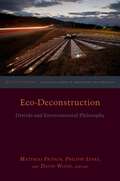
Eco-Deconstruction: Derrida and Environmental Philosophy (Groundworks: Ecological Issues in Philosophy and Theology)
By Matthias Fritsch, Philippe Lynes, and David Wood. 2018
Eco-Deconstruction marks a new approach to the degradation of the natural environment, including habitat loss, species extinction, and climate change.…
While the work of French philosopher Jacques Derrida (1930–2004), with its relentless interrogation of the anthropocentric metaphysics of presence, has already proven highly influential in posthumanism and animal studies, the present volume, drawing on published and unpublished work by Derrida and others, builds on these insights to address the most pressing environmental issues of our time.The volume brings together fifteen prominent scholars, from a wide variety of related fields, including eco-phenomenology, eco-hermeneutics, new materialism, posthumanism, animal studies, vegetal philosophy, science and technology studies, environmental humanities, eco-criticism, earth art and aesthetics, and analytic environmental ethics. Overall, eco-deconstruction offers an account of differential relationality explored in a non-totalizable ecological context that addresses our times in both an ontological and a normative register.The book is divided into four sections. “Diagnosing the Present” suggests that our times are marked by a facile, flattened-out understanding of time and thus in need of deconstructive dispositions. “Ecologies” mobilizes the spectral ontology of deconstruction to argue for an originary environmentality, the constitutive ecological embeddedness of mortal life. “Nuclear and Other Biodegradabilities,” examines remains, including such by-products and disintegrations of human culture as nuclear waste, environmental destruction, and species extinctions. “Environmental Ethics” seeks to uncover a demand for justice, including human responsibility for suffering beings, that emerges precisely as a response to original differentiation and the mortality and unmasterable alterity it installs in living beings. As such, the book will resonate with readers not only of philosophy, but across the humanities and the social and natural sciences.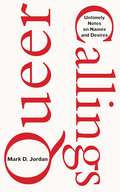
Queer Callings: Untimely Notes on Names and Desires
By Mark D. Jordan. 2024
CHOICE: OUTSTANDING ACADEMIC TITLEFINALIST, THE RANDY SHILTS AWARD FOR GAY NONFICTION, THE PUBLISHING TRIANGLE AWARDSA passionate exhortation to expand the…
ways we talk about human sex, sexuality, and gender.Twenty-five years ago, Mark D. Jordan published his landmark book on the invention and early history of the category “sodomy,” one that helped to decriminalize certain sexual acts in the United States and to remove the word sodomy from the updated version of a standard English translation of the Christian Bible. In Queer Callings, Jordan extends the same kind of illuminating critical analysis to present uses of “identity” with regard to sexual difference. While the stakes might not seem as high, he acknowledges, his newest history of sexuality is just as vital to a better present and future.Shaking up current conversations that focus on “identity language,” this essential new book seeks to restore queer languages of desire by inviting readers to consider how understandings of “sexual identity” have shifted—and continue to shift—over time. Queer Callings re-reads texts in various genres—literary and political, religious and autobiographical—that have been preoccupied with naming sex/gender diversity beyond a scheme of LGBTQ+ identities. Engaging a wide range of literary and critical works concerned with sex/gender self-understanding in relation to “spirituality,” Jordan takes up the writings of Oscar Wilde, Marcel Proust, Djuna Barnes, Samuel R. Delany, Audre Lorde, Geoff Mains, Eve Kosofsky Sedgwick, Gloria Anzaldúa, Maggie Nelson, and others.Before it’s possible to perceive sexual identities differently, Jordan argues, current habits for classifying them have to be disrupted. In this way, Queer Callings asks us to reach beyond identity language and invites us to re-perform a selection of alternate languages—some from before the invention of phrases like “sexual identity,” others more recent. Tracing a partial genealogy for “sexual identity” and allied phrases, Jordan reveals that the terms are newer than we might imagine. Many queer folk now counted as literary or political ancestors didn’t claim a sexual or gender identity: They didn’t know they were supposed to have one. Finally, Queer Callings joins the writers it has evoked to resist any remaining confidence that it’s possible to give neatly contained accounts of human desire. Reaching into the past to open our eyes to extraordinary opportunities in our present and future, Queer Callings is a generatively destabilizing and essential read.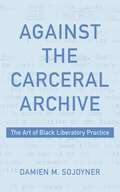
Against the Carceral Archive: The Art of Black Liberatory Practice
By Damien Sojoyner. 2023
Against the Carceral Archive is a meditation upon what author Damien M. Sojoyner calls the “carceral archival project,” offering a…
distillation of critical, theoretical, and activist work of prison abolitionists over the past three decades. Working from collections at the Southern California Library (Black Panthers, LA Chapter; the Coalition Against Police Abuse; Urban Policy Research Institute; Mothers Reclaiming Our Children; and the collection of geographer Clyde Woods), it builds upon theories of the archive to examine carcerality as the dominant mode of state governance over Black populations in the United States since the 1960s.Each chapter takes up an element of the carceral archive and its destabilization, destruction, and containment of Black life: its notion of the human and the production of “pejorative blackness,” the intimate connection between police and military in the protection of racial capitalism and its fossil fuel–based economy, the role of technology in counterintelligence, and counterinsurgency logics. Importantly, each chapter also emphasizes the carceral archive’s fundamental failure to destroy “Black communal logics” and radical Black forms of knowledge production, both of which contest the carceral archive and create other forms of life in its midst. Concluding with a statement on the reckoning with the radical traditions of thought and being which liberation requires, Sojoyner offers a compelling argument for how the centering of Blackness enables a structuring of the mind that refuses the violent exploitative tendencies of Western epistemological traditions as viable life-affirming practices.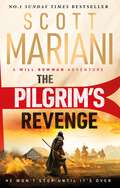
**Pre-order The Knight's Pledge, the second book in the Will Bowman series, now!**1190 - Humble layman Will Bowman lives in…
the countryside with his pregnant wife, when soldiers from Richard Lionheart's army tear through his home. Will is beaten unconscious, and awakes to find his wife murdered, his farm burnt down, and his life forever changed. In vengeance, Will infiltrates Richard's army to find the marauding gang, and finds himself swept along in the march of the Crusades. With the help of new allies and fuelled by his loss, Will crosses Europe with the King's army.Can Will avenge his wife? Or will he be swept away by the unstoppable force of Richard's Crusade?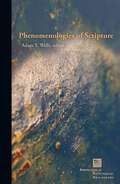
Phenomenologies of Scripture (Perspectives in Continental Philosophy)
By Adam Y. Wells. 2018
Phenomenologies of Scripture addresses two increasingly convergent disciplines: philosophy and biblical studies. On the one hand, the recent “theological turn”…
in phenomenology has established religion as a legitimate area of phenomenological inquiry. If that turn is to be enduringly successful, phenomenology must pay attention to the scriptures on which religious life, practice, and thought are based. On the other hand, biblical studies finds itself in a methodological morass. Contemporary approaches to scripture have raised important questions about the meaning and function of scriptural texts that phenomenology is uniquely positioned to answer: How is the meaning of a text constructed or gleaned? How can the divine be present in human words? Is a scientific approach to the Bible still possible? Bringing together essays by eight of today’s most prominent philosophers of religion with responses by two leading biblical scholars, Phenomenologies of Scripture reestablishes the possibility of fruitful, dialectical exchange between fields that demand to be read together.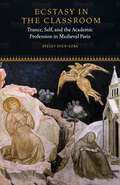
Can ecstatic experiences be studied with the academic instruments of rational investigation? What kinds of religious illumination are experienced by…
academically minded people? And what is the specific nature of the knowledge of God that university theologians of the Middle Ages enjoyed compared with other modes of knowing God, such as rapture, prophecy, the beatific vision, or simple faith? Ecstasy in the Classroom explores the interface between academic theology and ecstatic experience in the first half of the thirteenth century, formative years in the history of the University of Paris, medieval Europe’s “fountain of knowledge.” It considers little-known texts by William of Auxerre, Philip the Chancellor, William of Auvergne, Alexander of Hales, and other theologians of this community, thus creating a group portrait of a scholarly discourse. It seeks to do three things. The first is to map and analyze the scholastic discourse about rapture and other modes of cognition in the first half of the thirteenth century. The second is to explicate the perception of the self that these modes imply: the possibility of transformation and the complex structure of the soul and its habits. The third is to read these discussions as a window on the predicaments of a newborn community of medieval professionals and thereby elucidate foundational tensions in the emergent academic culture and its social and cultural context. Juxtaposing scholastic questions with scenes of contemporary courtly romances and reading Aristotle’s Analytics alongside hagiographical anecdotes, Ecstasy in the Classroom challenges the often rigid historiographical boundaries between scholastic thought and its institutional and cultural context.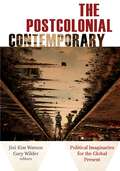
The Postcolonial Contemporary: Political Imaginaries for the Global Present
By Jini Kim Watson and Gary Wilder, Editors. 2018
This volume invokes the “postcolonial contemporary” in order to recognize and reflect upon the emphatically postcolonial character of the contemporary…
conjuncture, as well as to inquire into whether postcolonial criticism can adequately grasp it. Neither simply for nor against postcolonialism, the volume seeks to cut across this false alternative, and to think with postcolonial theory about political contemporaneity.Many of the most influential frameworks of postcolonial theory were developed during the 1970s and 1990s, during what we may now recognize as the twilight of the postwar period. If forms of capitalist imperialism are entering into new configurations of neoliberal privatization, wars-without-end, xenophobic nationalism and unsustainable extraction, what aspects of postcolonial inquiry must be reworked or revised in order to grasp our political present?In twelve essays that draw from a number of disciplines—history, anthropology, literature, geography, indigenous studies— and regional locations (the Black Atlantic, South Africa, South Asia, East Asia, Australia, Argentina) The Postcolonial Contemporary seeks to move beyond the habitual oppositions that have often characterized the field, such as universal vs. particular; Marxism vs. postcolonialism; and politics vs. culture. These essays signal an attempt to reckon with new and persisting postcolonial predicaments and do so under four inter-related analytics: Postcolonial Temporality; Deprovincializing the Global South; Beyond Marxism versus Postcolonial Studies; and Postcolonial Spatiality and New Political Imaginaries.